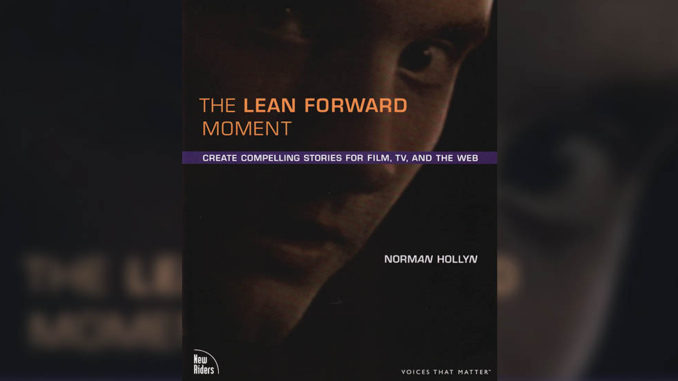
By Ray Zone
The Lean Forward Moment
Create Compelling Stories for Film, TV and the Web
by Norman Hollyn
New Riders
364 pps., paperbound, $44.99
ISBN: 0-321-58545-3
Norman Hollyn has crafted an unusual book. By taking a central concept––that of storytelling and how it holds our interest in moving-image media––he has found a unique way to discuss filmmaking in its various aspects. It is a work of analysis that places narrative at the core of its discussion and examines how different tools and skills of filmmaking serve that integral concept. The central issue is emotional engagement in the narrative, to “affect the audience” and how that is achieved with instances of dramatic change in a story that constitute what Hollyn characterizes as the “lean forward moment.”
Right at the beginning of the book, Hollyn, an occasional contributor to Editors Guild Magazine, acknowledges that its origin “is utterly informed by my experience as an editor. It is a look at storytelling, molded by my years of constantly rewriting. For that is precisely what editors do.” It’s a unique perspective, comparing editing to writing, with storytelling as the conceptual epicenter. Hollyn has worked in the entertainment industry for over 30 years as a music, sound and picture editor. But when he started teaching at the USC School of Cinematic Arts (where he is now associate professor and Editing Track head), he queried himself about what it is an editor actually does. And the simple answer was “storytelling.”
More importantly, the overriding goal in telling a story with moving images, is “to affect the audience,” whether the narrative type is a documentary, a feature film, a corporate video or a wedding event. By having his students and readers ask themselves, “What is the story of the scene?” the process of filmmaking is greatly simplified. “Once we understand these things,” notes Hollyn, “then it is much easier to figure out how to direct the scene, light it or musically score it.” The term “film” is used herein as applicable to any moving-image medium.
In the first chapter, “How We Tell Stories,” Hollyn sets the context for the entire book. “Film is about change,” he writes. “Drama in film is doubly about that. Writers shape their stories around it, directors look to exploit it, cinematographers shoot for it and editors cut for that change, whether consciously or subconsciously.” Hollyn has used a handful of examples that illustrate concepts discussed, particularly The Godfather, Citizen Kane, The Matrix, Jean Luc Godard’s Contempt, student short films, TV shows and webisodes. And he revisits each of his examples in separate chapters on writing, production design, directing, cinematography, editing, visual effects, music and sound.
Editing, Norman Hollyn acknowledges, is what differentiates film from photography, theatre, painting, and the other visual arts.
In working to create compelling moments to affect the audience, Hollyn cites the “Rule of Threes,” which is about the sequence of shots. He states the rule as follows: “The impact of a shot, a scene or a sequence depends on the shot, scene or sequence that came before it. That shot, scene or sequence will also directly affect the shot, scene or sequence that comes after it.” That is certainly a rule of which Eisenstein would have approved but, somewhat surprisingly, Battleship Potemkin and its famous “Odessa steps” sequence is one of the cinematic examples Hollyn uses in his book to illustrate the fact that “there is much more going on in this scene than editing choices.”
In chapter two of the book, Hollyn sets up his examples with a demonstration of the logline and its importance to an understanding of the film. To write an effective logline for a film, an analysis of a story and its key scenes must take place. Hollyn here advises the reader to stop reading and to immediately watch a scene from The Godfather, which is discussed in nearly every chapter of the book. Throughout the book are embedded loglines and scene analyses supplementing the text along with effective charts for camera placement and film frames. Here is one very good tip: “Every scene in a project must push its story forward.”
Hollyn’s diverse examples (a scene from the reality TV series, The Real World: Los Angeles, for example) underscore the importance of the emotional architectonics of narrative, and how they can be universally applied to any moving image story. Even the episodic online series Satacracy 88 is given an in-depth discussion about audience involvement, particularly cogent with this example because the audience actually votes to determine the outcome of the plot.
With his chapter on editing, Hollyn again reinforces the connection between writing and editing. “Editing is often referred to as ‘the final rewrite,’” he observes. “They are both concerned with character arcs, pacing and story shape. The main difference between the two is that writers work with an infinite range of possibilities (the ‘blank page’) and editors work with what has been shot.”
Editing, Hollyn acknowledges, is what differentiates film from photography, theatre, painting, and the other visual arts. In an epigraph to this chapter, Francis Ford Coppola is quoted as stating that “The essence of cinema is editing.” Discussions of emotional engagement for the audience and driving stories forward are usually made within the pages of books about screenwriting. It’s rare to see such a discussion address all aspects of production, from beginning to end, and still maintain an artistic point of view that is editor-specific in world view. It’s a welcome and highly individual approach in a field increasingly crowded with books about filmmaking.





